Mortar with Internal Curing Bottom Ash for Sand Shortage and Proper Curing
Abstract
:1. Introduction
2. Materials and Methods
2.1. Materials
2.2. Mix Proportions
2.3. Experimental Methods
3. Results and Discussion
3.1. Initial Flow
3.2. Compressive Strength
3.3. Heat Flow
3.4. Microstructure Characterization Using EPMA
3.5. TGA Results
3.6. MIP Results
4. Conclusions
- The workability of mortar with BA increases due to the lubrication of the fresh mortar with pre-wetted BA, which greatly reduces the friction between each particle;
- The compressive strength of mortar with BA decreased with an increasing BA replacement level—the 28 d compressive strength exceeded 50 MPa. Moreover, the mortar with lignite BA achieved a higher compressive strength than the reference mortar;
- The heat peak of mortar with BA is found to be higher than that of the reference mortar due to the increase in heat release following hydration with BA;
- The high levels of CA in local areas of mortar with BA (both bituminous BA and lignite BA) present at early ages (3 d to 7 d) became uniformly distributed, with nearby interfaces at later ages. This may be due to the increase in the hydration reaction caused by BA;
- Compared with bituminous BA, lignite BA has a greater potential capacity to improve the workability, increase the hydration levels, and enhance the compressive strength;
- The degree of pore structure refinement in mortar with lignite BA was found to be greater than in mortar without BA.
Author Contributions
Funding
Institutional Review Board Statement
Informed Consent Statement
Data Availability Statement
Acknowledgments
Conflicts of Interest
References
- Muralitharan, R.S.; Ramasamy, V. Development of lightweight concrete for structural applications. J. Struct. Eng. 2017, 44, 336–344. [Google Scholar]
- Akcay, B.; Tasdemir, M.A. Effect of distribution of lightweight aggregates on internal curing of concrete. Cem. Concr. Com. 2010, 32, 611–616. [Google Scholar] [CrossRef]
- Assaad, J.J.; Mikhael, C.; Hanna, R. Recycling of waste expanded polystyrene concrete in lightweight sandwich panels and structural applications. Clean. Mater. 2022, 4, 100095. [Google Scholar] [CrossRef]
- Yang, K.H.; Kim, G.H.; Choi, Y.H. An initial trial mixture proportioning procedure for structural lightweight aggregate concrete. Construct. Build. Mat. 2014, 55, 431–439. [Google Scholar] [CrossRef]
- Lee, H.K.; Kim, H.K.; Hwang, E.A. Utilization of power plant bottom ash as aggregates in fiber-reinforced cellular concrete. Wast. Manag. 2010, 30, 274–284. [Google Scholar] [CrossRef] [PubMed]
- Suksiripattanapong, C.; Krosoongnern, K.; Thumrongvut, J.; Sukontasukkul, P.; Horpibulsuk, S.; Chindaprasirt, P. Properties of cellular lightweight high calcium bottom ash-portland cement geopolymer mortar. Case Stud. Constr. Mater. 2020, 12, e00337. [Google Scholar] [CrossRef]
- Damene, Z.; Goual, M.S.; Houessou, J.; Dheilly, R.M.; Goullieux, A.; Quéneudec, M. The use of southern Algeria dune sand in cellular lightweight concrete manufacturing: Effect of lime and aluminium content on porosity, compressive strength and thermal conductivity of elaborated materials. Eur. J. Environ. Civ. Eng. 2016, 22, 1273–1289. [Google Scholar] [CrossRef]
- Agostini, F.; Davy, C.A.; Skoczylas, F.; Dubois, T. Effect of microstructure and curing conditions upon the performance of a mortar added with treated sediment aggregates (TSA). Cem. Concr. Res. 2010, 40, 1609–1619. [Google Scholar] [CrossRef]
- Bentur, A.; Igarashi, S.; Kovler, K. Prevention of autogenous shrinkage in high-strength concrete by internal curing using wet lightweight aggregates. Cem. Concr. Res. 2001, 31, 1587–1591. [Google Scholar] [CrossRef]
- Weber, S.; Reinhardt, H.W. A new generation of high performance concrete: Concrete with autogenous curing. Adv. Cem. Based Mater. 1997, 6, 59–68. [Google Scholar] [CrossRef]
- Bentz, D.P.; Snyder, K.A. Protected paste volume in concrete: Extension to internal curing using saturated lightweight fine aggregate. Cem. Concr. Res. 1999, 29, 1863–1867. [Google Scholar] [CrossRef]
- Cusson, D.; Hoogeveen, T. Internal curing of high-performance concrete with pre-soaked fine lightweight aggregate for prevention of autogenous shrinkage cracking. Cem. Concr. Res. 2008, 38, 757–765. [Google Scholar] [CrossRef]
- Wasserman, R.; Bentur, A. Interfacial interactions in lightweight aggregate concretes and their influence on the concrete strength. Cem. Concr. Compos. 1996, 18, 67–76. [Google Scholar] [CrossRef]
- Scrivener, K.L.; Crumbie, A.K.; Laugesen, P. The interfacial transition zone (ITZ) between cement paste and aggregate in concrete. Interface Sci. 2004, 12, 411–421. [Google Scholar] [CrossRef]
- Larbi, J.A. Microstructure of the interfacial zone around aggregate particles in concrete. Heron 1993, 38, 1–69. [Google Scholar]
- Lo, T.Y.; Cui, H.Z. Effect of porous lightweight aggregate on strength of concrete. Mater. Lett. 2004, 58, 916–919. [Google Scholar] [CrossRef]
- Lo, T.Y.; Cui, H.Z. Spectrum analysis of the interfacial zone of lightweight aggregate concrete. Mater. Lett. 2004, 58, 3089–3095. [Google Scholar] [CrossRef]
- Kim, H.K.; Lee, H.K. Hydration kinetics of high strength concrete with untreated coal bottom ash for internal curing. Cem. Concr. Compos. 2018, 91, 67–75. [Google Scholar] [CrossRef]
- Gao, X.; Yuan, Q.L.; Yu Brouwers, H.J.H. Characterization and application of municipal solid waste incineration (MSWI) bottom ash and waste granite powder in alkali activated slag. J. Clean. Prod. 2017, 164, 410–419. [Google Scholar] [CrossRef]
- Pa, S.; Shariq, M.; Abbas, H.; Pandit, A.K.; Masood, A. Strength characteristics and microstructure of hooked-end steel fiber reinforced concrete containing fly ash, bottom ash and their combination. Constr. Build. Mater. 2020, 247, 118530. [Google Scholar] [CrossRef]
- Fang, G.; Zhang, M. The evolution of interfacial transition zone in alkali-activated fly ash-slag concrete. Cem. Concr. Res. 2020, 129, 105963. [Google Scholar] [CrossRef]
- Tu, W.; Zhu, Y.; Fang, G.; Wang, X.; Zhang, M. Internal curing of alkali-activated fly ash–slag pastes using superabsorbent polymer. Cem. Concr. Res. 2019, 116, 179–190. [Google Scholar] [CrossRef]
- Pane, I.; Hansen, W. Investigation of blended cement hydration by isothermal calorimetry and thermal analysis. Cem. Concr. Res. 2005, 35, 1155–1164. [Google Scholar] [CrossRef]
- Lefever, G.; Tsangouri, E.; Snoeck, D.; Aggelis, D.G.; Belie, N.D.; Vlierberghe, S.V.; Hemelrijck, D.V. Combined use of superabsorbent polymers and nanosilica for reduction of restrained shrinkage and strength compensation in cementitious mortars. Constr. Build. Mater. 2020, 251, 118966. [Google Scholar] [CrossRef]
- Shen, P.; Lu, L.; Wang, F.; He, Y.; Hu, S.; Lu, J.; Zheng, H. Water desorption characteristics of saturated lightweight fine aggregate in ultra-high performance concrete. Cem. Concr. Com. 2020, 106, 103456. [Google Scholar] [CrossRef]
- Qin, X.; Shen, A.; Lyu, Z.; Shi, L.; Yang, J.; Liu, H. Research on water transport behaviors and hydration characteristics of internal curing pavement concrete. Constr. Build. Mater. 2020, 248, 118714. [Google Scholar] [CrossRef]
- Elsharief, A.; Cohen, M.D.; Olek, J. Influence of lightweight aggregate on the microstructure and durability of mortar. Cem. Concr. Res. 2005, 35, 1368–1376. [Google Scholar] [CrossRef]
- Kim, H.K.; Ha, K.A.; Lee, H.K. Internal-curing efficiency of cold-bonded bottom ash aggregate for high-strength mortar. Constr. Build. Mater. 2016, 126, 1–8. [Google Scholar] [CrossRef]



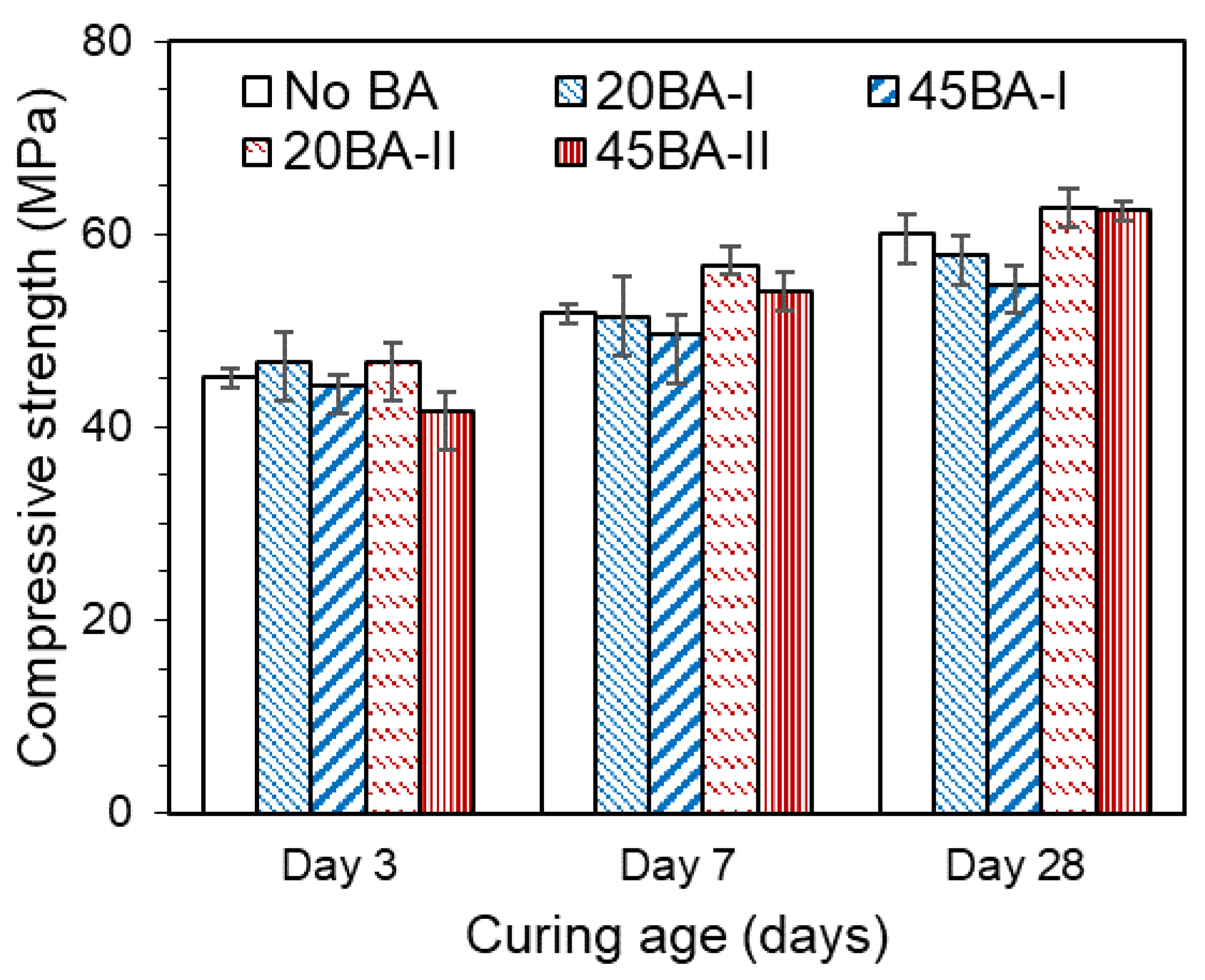
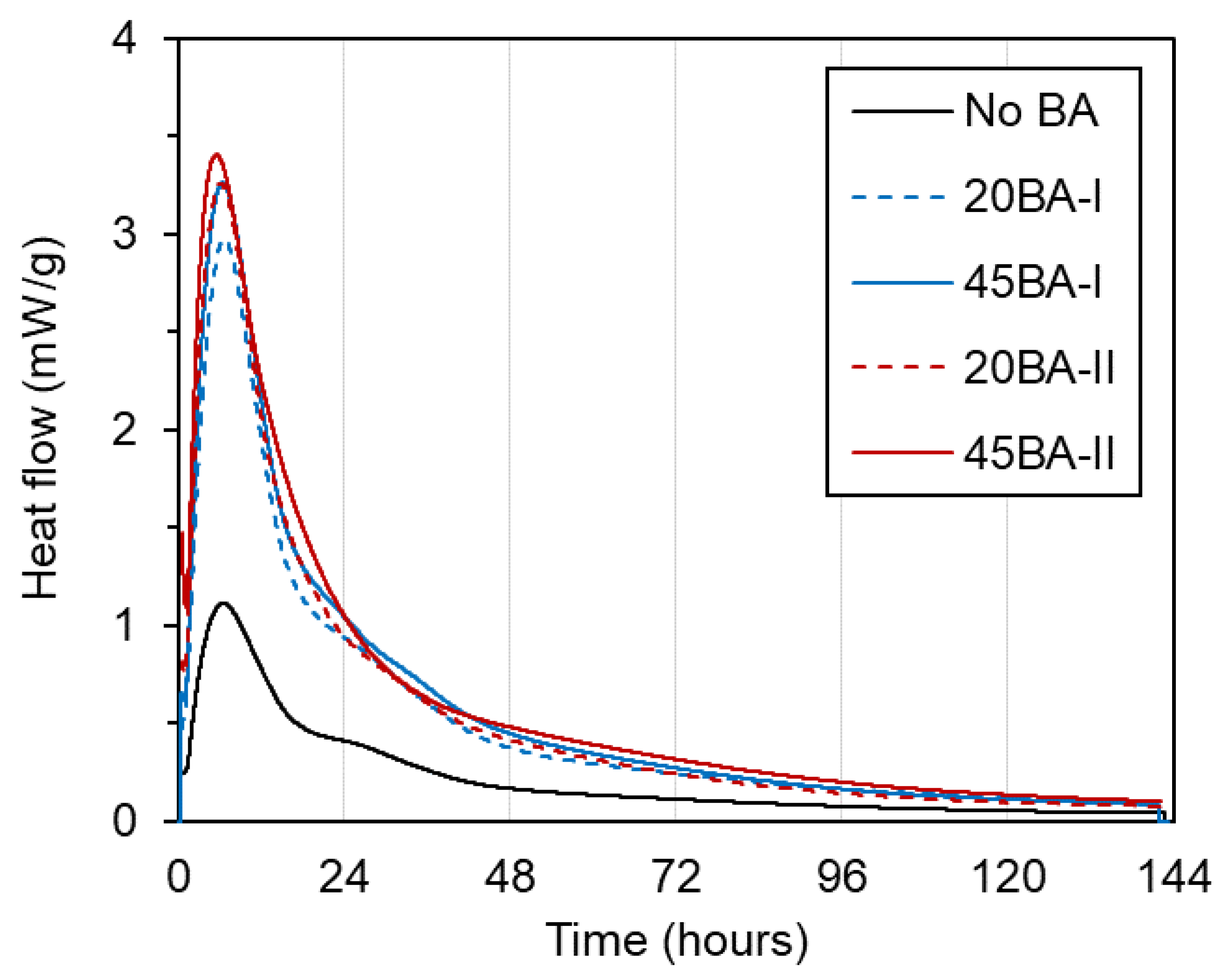
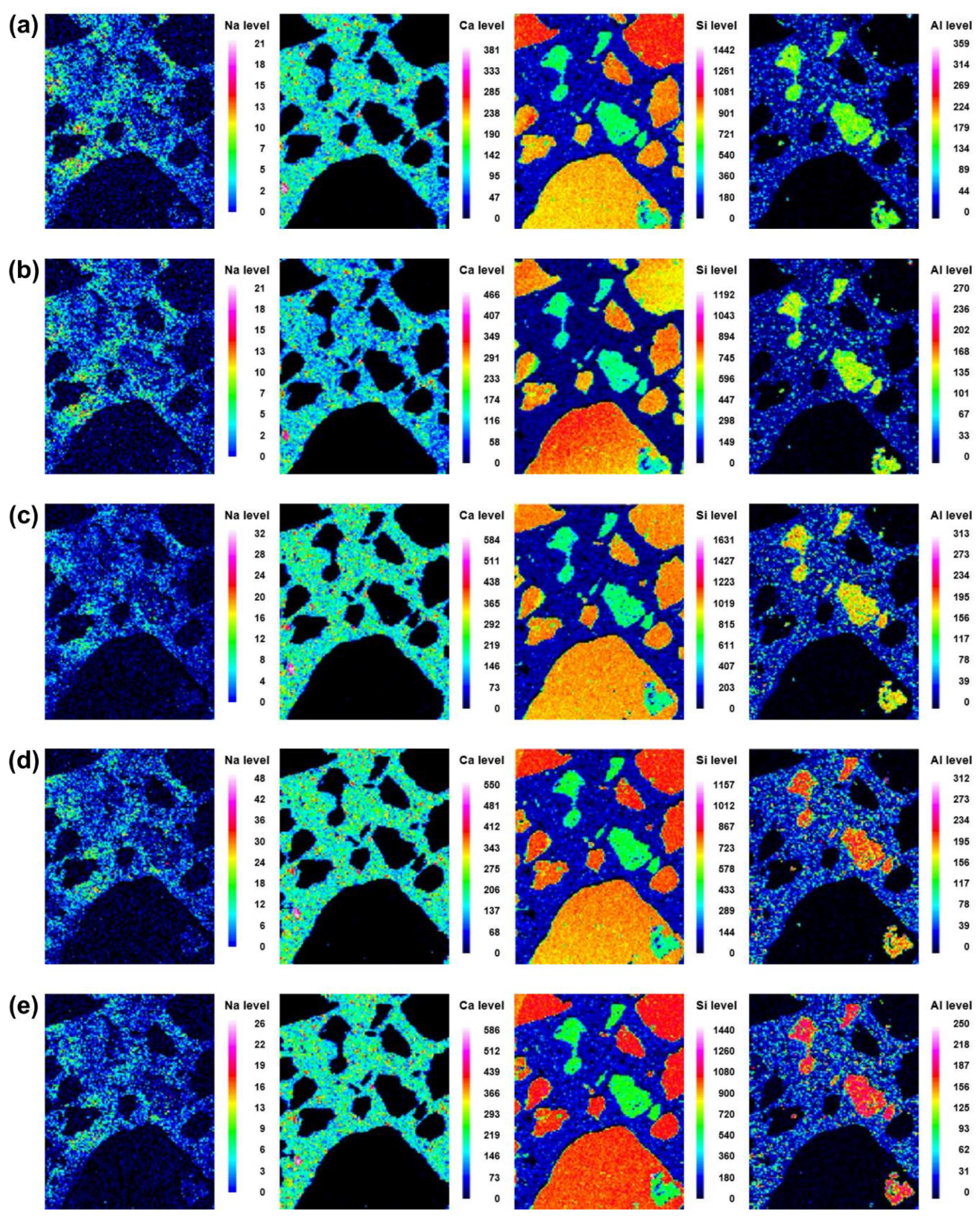
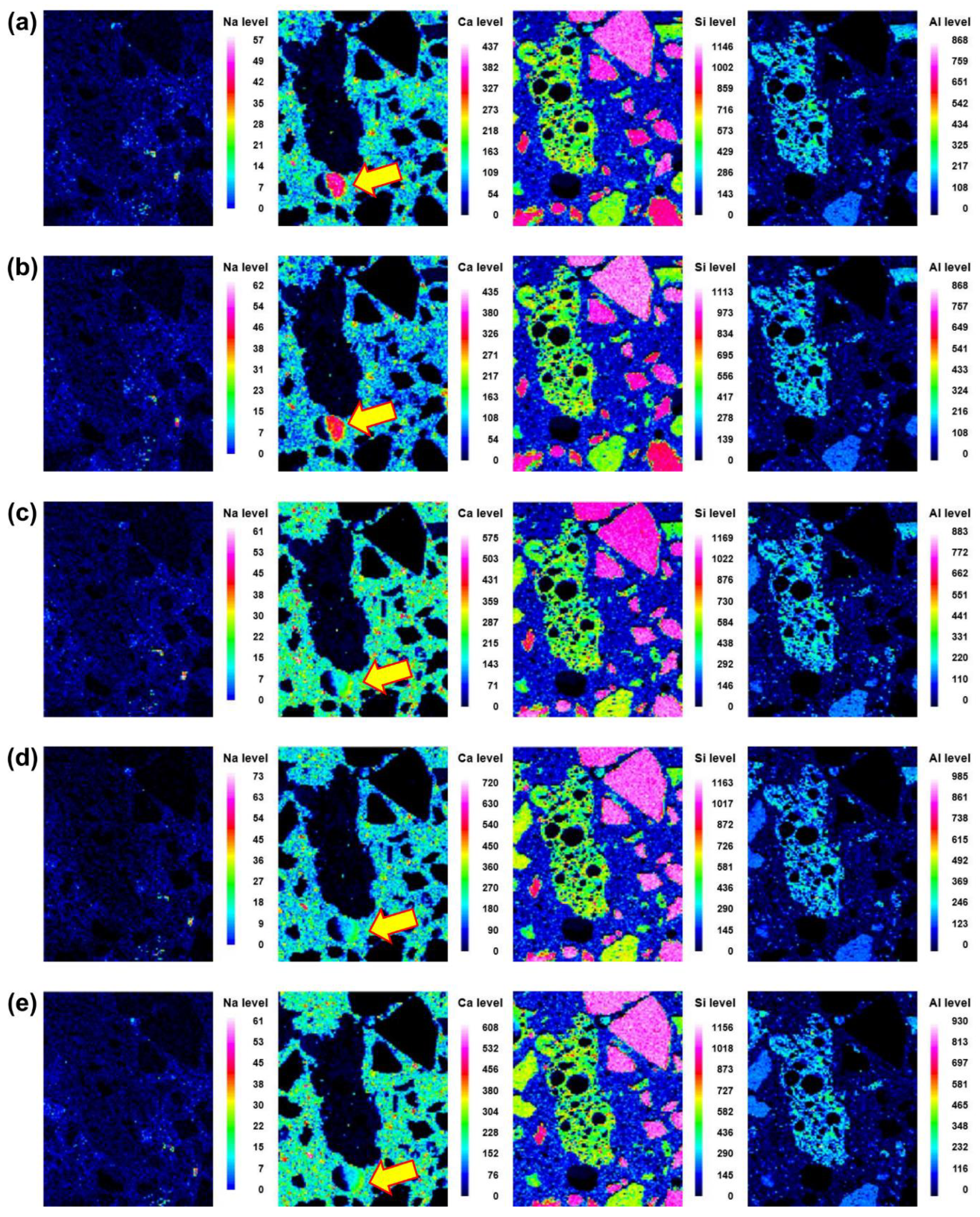
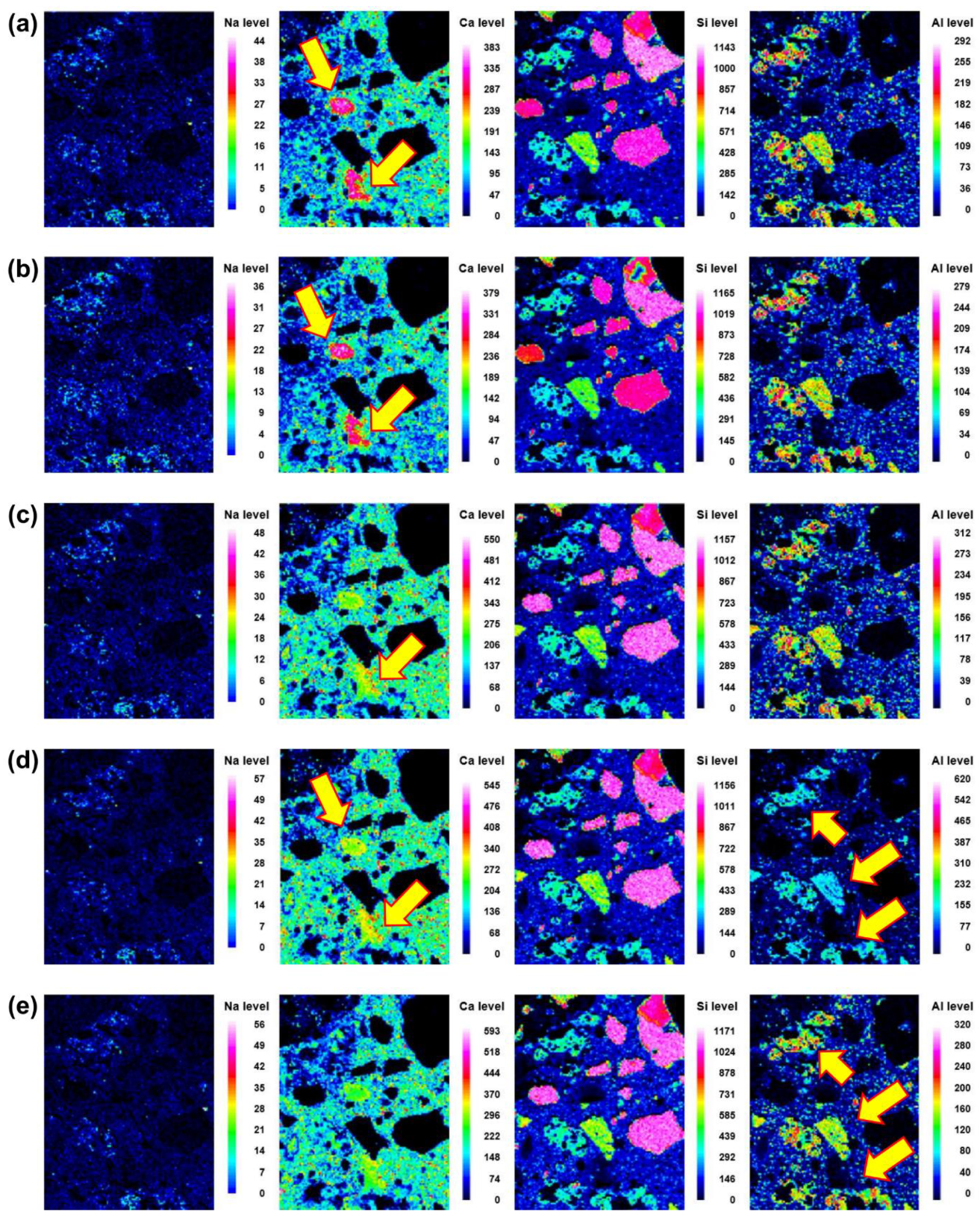
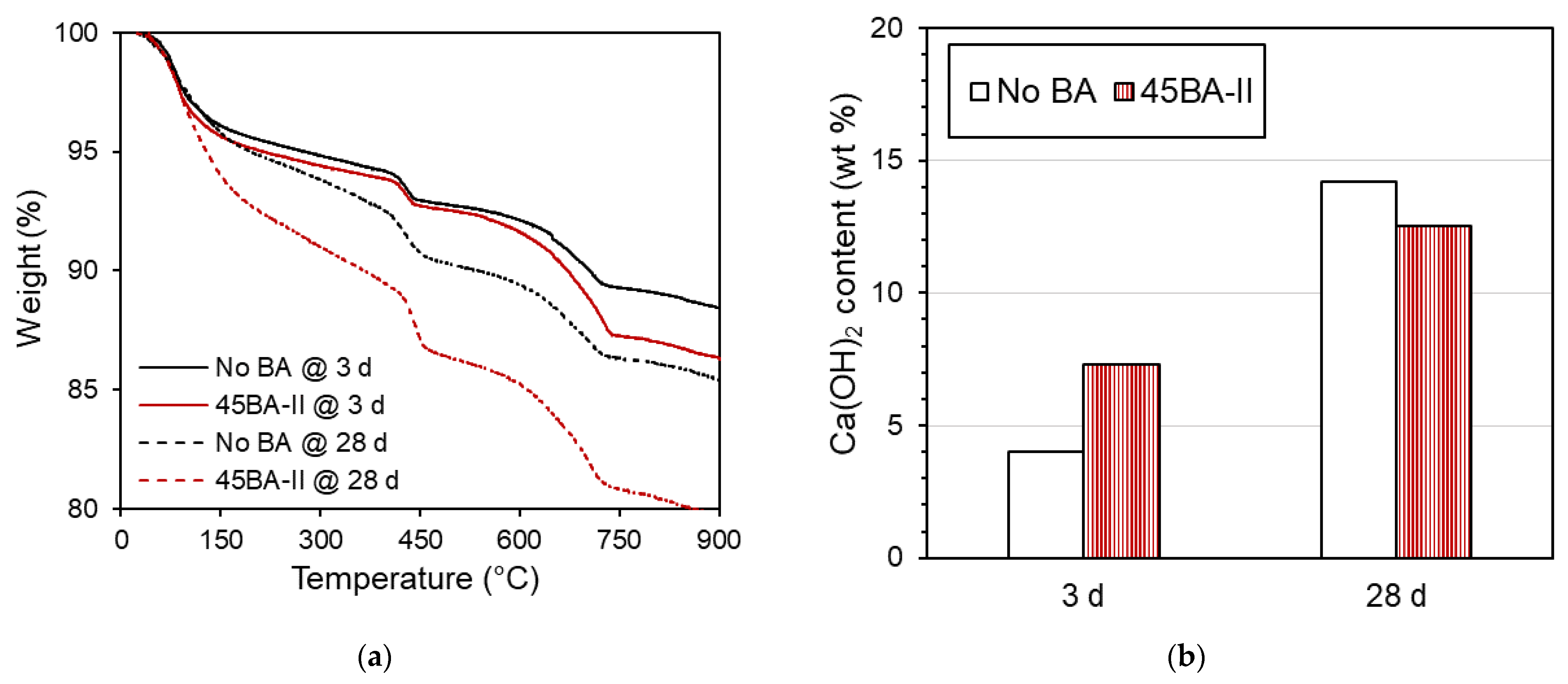
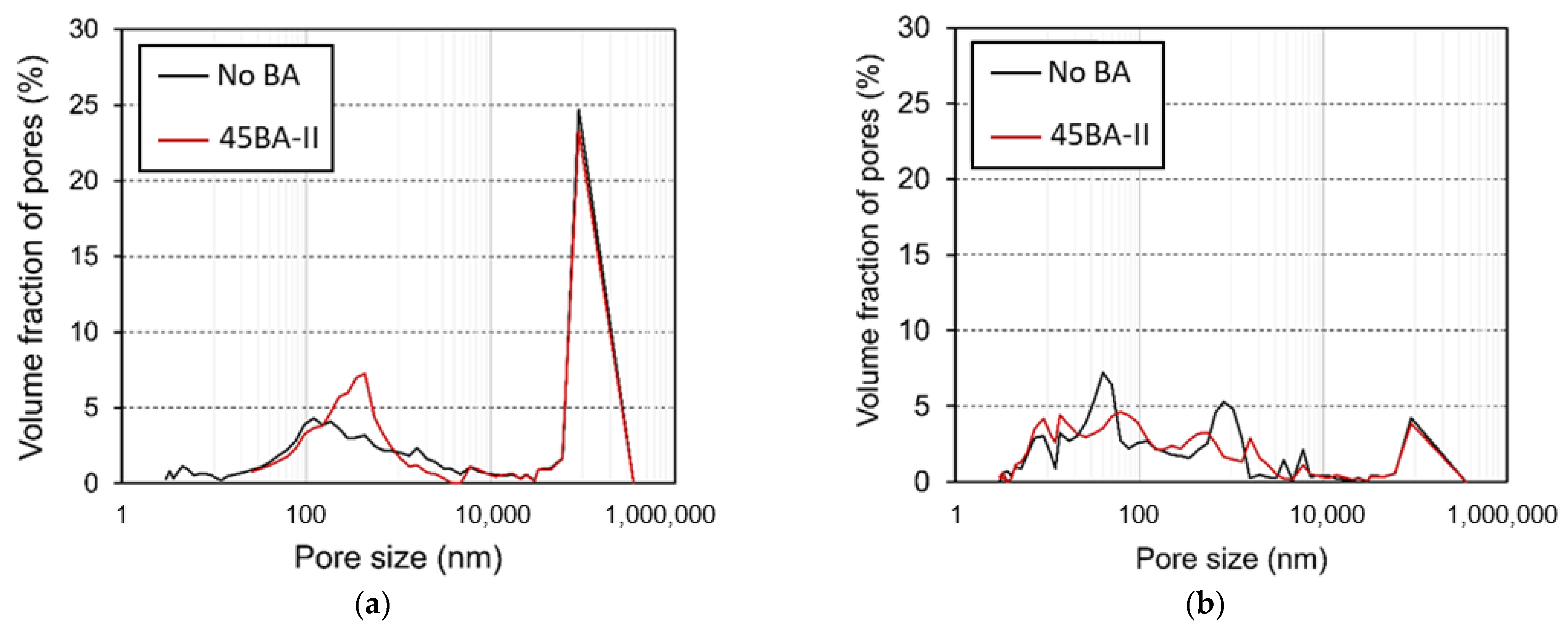
| Chemical Composition (wt. %) | BA-I | BA-II |
|---|---|---|
| SiO2 | 55.3 | 15.1 |
| Al2O3 | 18.3 | 7.1 |
| Fe2O3 | 13.9 | 27.1 |
| CaO | 4.1 | 28.6 |
| K2O | 2.4 | 2.4 |
| TiO2 | 4.0 | 0.8 |
| SO3 | - | 4.4 |
| Type of Lightweight Aggregate | River Sand | BA-I | BA-II |
|---|---|---|---|
| Specific gravity | |||
| saturated surface dry | 2.60 | - | - |
| Oven dry | 2.57 | 1.51 | 1.76 |
| Wetted saturated dry | - | 1.76 | 2.09 |
| Fineness modulus | 2.95 | 2.17 | 2.93 |
| Water absorption (wt. %) | 1.15 | 13.32 * | 19.19 * |
| Mass of water release at 94%RH | - | 0.0936 * | 0.1573 * |
| Mix Proportion (kg/m3) | Designation | ||||
|---|---|---|---|---|---|
| No BA | 20BA-I | 45BA-I | 20BA-II | 45BA-II | |
| Total water | 315 | 315 | 315 | 315 | 315 |
| Cement | 900 | 900 | 900 | 900 | 900 |
| Sand (SSD) | 1040 | 830 | 570 | 830 | 570 |
| BA (WSD) | - | 135 | 305 | 170 | 375 |
| BA (oven dry) | - | 119 | 269 | 143 | 316 |
| Water for internal curing | - | 11 | 25 | 21 | 47 |
| Total volumetric mass | 2255 | 2180 | 2090 | 2215 | 2160 |
| w/c | 0.35 | 0.35 | 0.35 | 0.35 | 0.35 |
| w/c from pre-wetted BA for internal curing | - | 0.04 | 0.08 | 0.07 | 0.15 |
| Equivalent w/c | 0.39 | 0.43 | 0.42 | 0.50 | |
| Initial flow (%) | 92 | 97 | 108 | 101 | 110 |
Disclaimer/Publisher’s Note: The statements, opinions and data contained in all publications are solely those of the individual author(s) and contributor(s) and not of MDPI and/or the editor(s). MDPI and/or the editor(s) disclaim responsibility for any injury to people or property resulting from any ideas, methods, instructions or products referred to in the content. |
© 2023 by the authors. Licensee MDPI, Basel, Switzerland. This article is an open access article distributed under the terms and conditions of the Creative Commons Attribution (CC BY) license (https://creativecommons.org/licenses/by/4.0/).
Share and Cite
Markpiban, P.; Krudam, W.; Sahamitmongkol, R. Mortar with Internal Curing Bottom Ash for Sand Shortage and Proper Curing. Buildings 2023, 13, 613. https://doi.org/10.3390/buildings13030613
Markpiban P, Krudam W, Sahamitmongkol R. Mortar with Internal Curing Bottom Ash for Sand Shortage and Proper Curing. Buildings. 2023; 13(3):613. https://doi.org/10.3390/buildings13030613
Chicago/Turabian StyleMarkpiban, Pochpagee, Wittawat Krudam, and Raktipong Sahamitmongkol. 2023. "Mortar with Internal Curing Bottom Ash for Sand Shortage and Proper Curing" Buildings 13, no. 3: 613. https://doi.org/10.3390/buildings13030613
APA StyleMarkpiban, P., Krudam, W., & Sahamitmongkol, R. (2023). Mortar with Internal Curing Bottom Ash for Sand Shortage and Proper Curing. Buildings, 13(3), 613. https://doi.org/10.3390/buildings13030613





